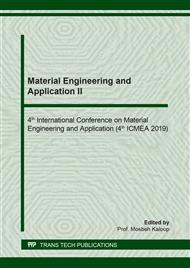[1]
Metalcor, CuCo1Ni1Be, Metalcor GmbH, Heidhauser Str. 89a, D-45239 Essen, Germany.
Google Scholar
[2]
N. J. Simon, E. S. Drexler, R. P. Reed, Properties of Copper and Copper Alloys at Cryogenic Temperatures, National Institute of Standards and Technology Monograph, Natl. Inst. Stand. Techno. Mono. 177 (1992).
DOI: 10.2172/5340308
Google Scholar
[3]
L. Collini, J. Trdine, Copper alloys-early applications and current performance-enhancing processes, 51000 Rijeka, Croatia, (2012).
Google Scholar
[4]
NGK Berylc o Europe, Beryllium Copper Alloys Technical Guide, Edition 01/(2014).
Google Scholar
[5]
R. Konečná, S. Fintová, Copper and Copper Alloys, Casting, Classification and Characteristic Microstructures, University of Žilina, Slovak Republic, (2012).
Google Scholar
[6]
G. Ventura, L. Risegari, The Art of Cryogenics Low-Temperature Experimental Techniques, First edition, Linacre House, Jordan Hill, Oxford OX2 8DP, UK 30 Corporate Drive, Suite 400, Burlington, MA 01803, USA, (2007) 37.
DOI: 10.1162/comj.2004.28.3.81
Google Scholar
[7]
K. D. Timmerhausand, R. P. Reed (Eds.), CRYOGENIC ENGINEERING Fifty Years of Progress, Chemical and Biological Engineering Department, University of Colorado, Boulder, Colorado, (2007).
Google Scholar
[8]
D. Thakur, B. Ramamoorthy, L. Vijayaeaghavan, Influence of different post treatment on tungsten carbide-cobalt insert, Mater. Lett. 62 2008 4403-4406.
DOI: 10.1016/j.matlet.2008.07.043
Google Scholar
[9]
Y. C. Tang, Y. L. Kang, L. J. Yue, X. L. Jiao, Precipitation Behavior of Cu-1.9Be-0.15Co Alloy During Aging, Acta Metall. Sin (Eng. Lett.) 28(3) (2015) 307-315.
DOI: 10.1007/s40195-014-0198-0
Google Scholar
[10]
K. Gu, H. Zhang, B. Zhao, J. Wang, Y. Zhou, Z. Q. Li, Effect of cryogenic treatment and aging treatment on the tensile properties and microstructure of Ti–6Al–4V alloy, Mater. Sci. Eng. A 584 (2013) 170-176.
DOI: 10.1016/j.msea.2013.07.021
Google Scholar
[11]
W. Ping, L. Wei, W. Yuehui, L. Jianhua, Z. Ruijun, Effects of cryogenic treatment on the thermal physical properties of Cu76.12Al23.88 alloy, RARE METALS, 30(6) (2011) 644.
Google Scholar
[12]
D. S. Nadig, V. Ramakrishnan, P. Sampathkumaran, C. S. Prashanth, Effect of cryogenic treatment on thermal conductivity properties of copper, AIP Conf. Proc. 1435 (2012) 133.
DOI: 10.1063/1.4712089
Google Scholar
[13]
R. Monzen, Y. Shimada, C. Watanabe, Mechanical properties of Cu-Ni-Be system alloy, J. Physic. Conf. Series 240 (2010).
Google Scholar
[14]
X. Guoliang, W. Qiangsong, M. Xujun, X. Baiqing, P. Lijun, The precipitation behaviour and strengthening of a Cu-2.0 wt% Be alloy, Mater. Sci. Eng. A 558 (2012) 326-330.
DOI: 10.1016/j.msea.2012.08.007
Google Scholar


